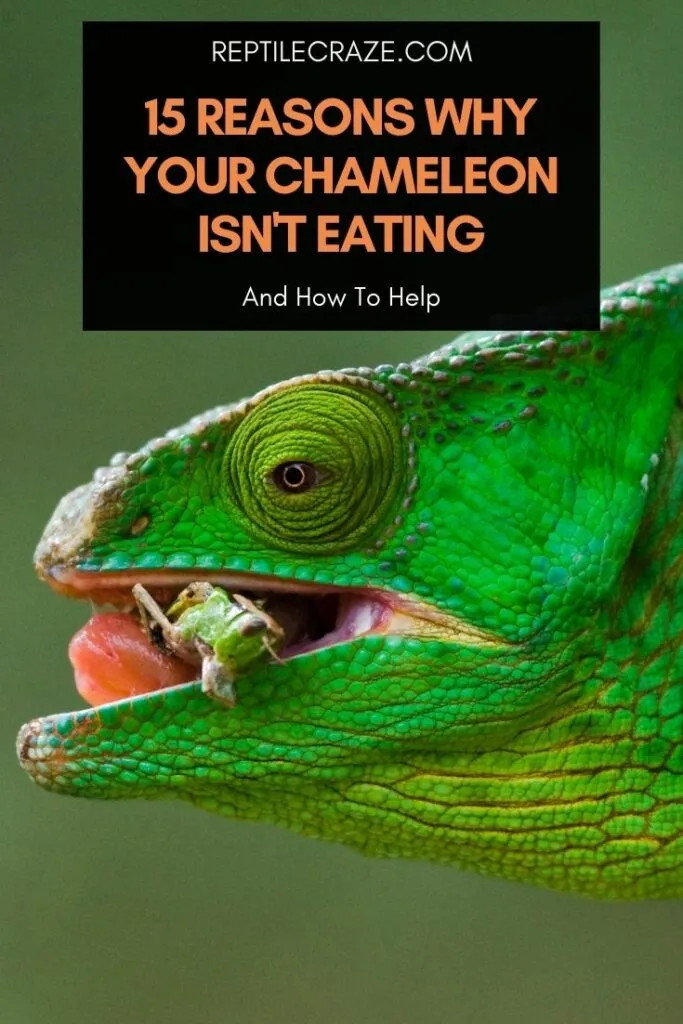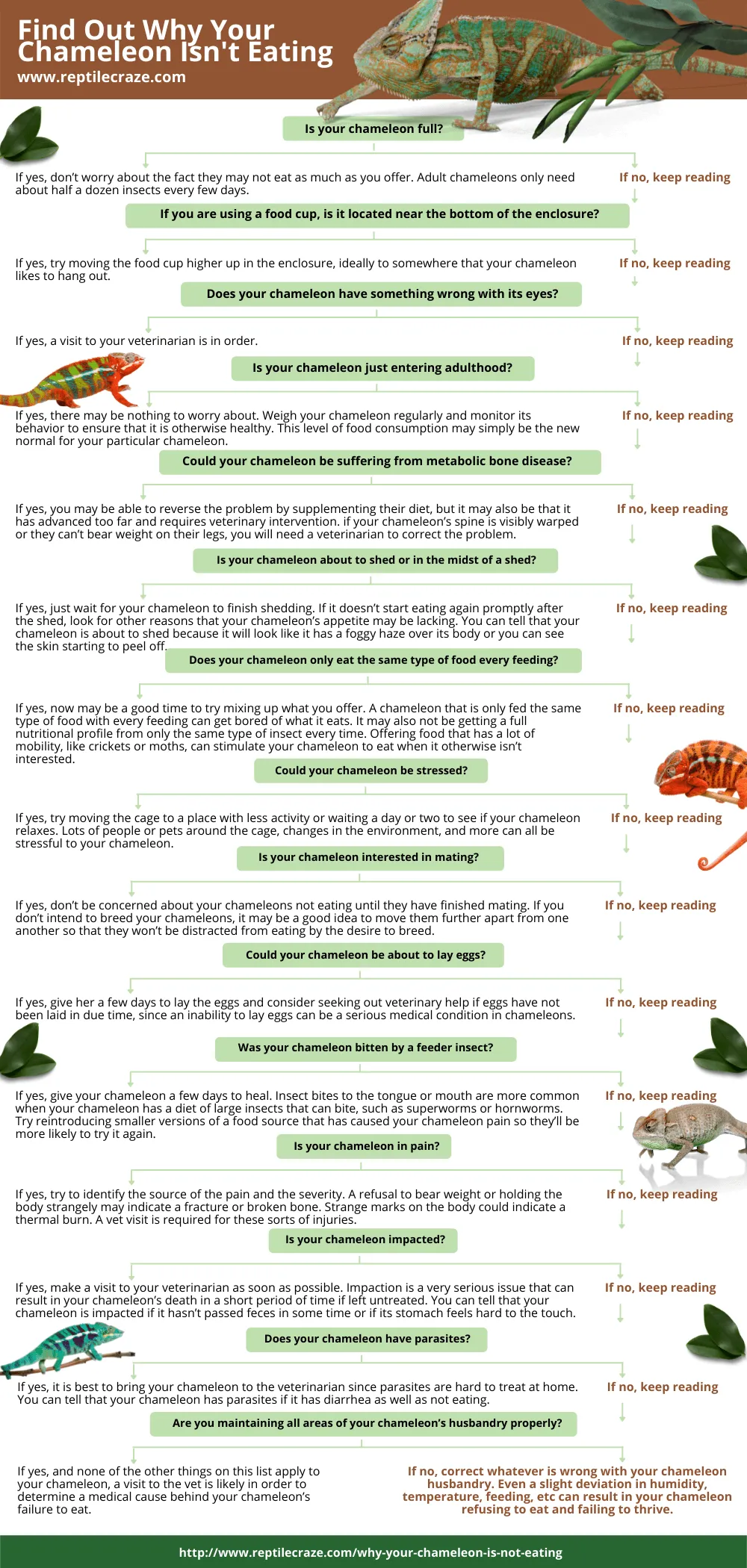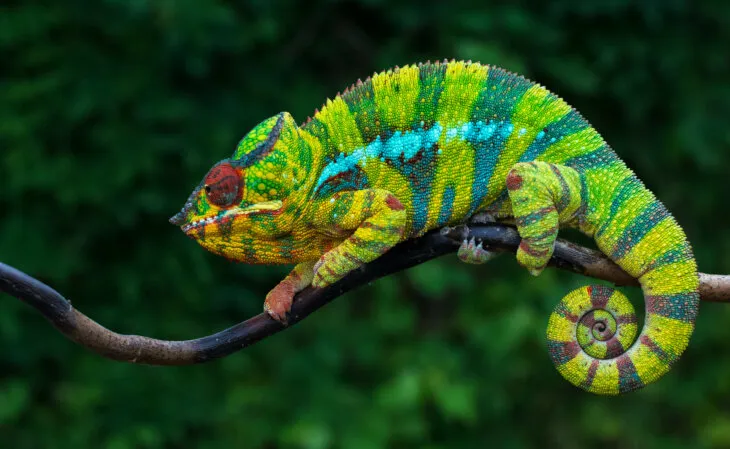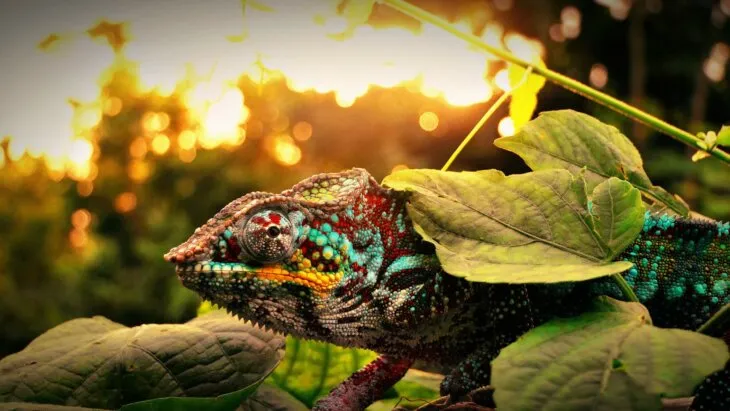
Watching a chameleon eat is one of the most fascinating things about having this reptile as a pet. If your chameleon is refusing to eat, you may be worrying about what might be wrong.
Sometimes a chameleon who is refusing to eat is perfectly healthy. Other times, a chameleon that isn’t eating is suffering from a serious issue. Here’s what you need to know about why your chameleon might be refusing food and what to do about it.
Find Out Why Your Chameleon Isn’t Eating
To make it easier for you to find out why your chameleon is not eating, we created the infographic below. By going through the questions in this decision tree you will find out what might be the reason for your chameleon’s behavior.
After that, we explain every reason for not eating in detail.

1. Your Chameleon May be Full
Some people assume that chameleons need to eat more than they really do. An adult chameleon usually only needs around half a dozen insects every few days.
If your chameleon isn’t eating every day or they aren’t eating as much as you offer them, it may simply be that you’re offering too much, too frequently.
Many chameleons in captivity are obese, which can normalize the condition for new keepers, making you think that your fit chameleon is actually underweight.
What to do about it
If your chameleon is eating approximately the correct amount for their age and size, coaxing them to eat more even when they’re full can result in health problems for them.
Instead, don’t worry about your chameleon not eating unless they adjust how much they eat dramatically.
2. The Food Isn’t High Enough to Get Your Chameleon’s Attention
Chameleons rarely go to the bottom of their enclosure. In the wild, chameleons would hardly ever leave the safety of the treetops, and they don’t want to go near the ground in your enclosure either.
Many keepers find it intuitive to put the cup of
Even if they do, they may be unwilling to approach the floor of the cage to eat it.
What to do about it
If your chameleon seemed disinterested in their
That makes it much more likely that your chameleon will notice and eat the
3. Your Chameleon is Suffering From Eye Problems
Chameleons are highly visual predators. Their eyes, which can operate independently of one another, are one of the most remarkable things about these fascinating reptiles. However, chameleons are extremely dependent on their eyes to hunt for prey.
If your chameleon can’t see prey moving, it is unlikely to be able to find and eat it. If your chameleon isn’t eating, it may be that they can’t see their
There are a number of things that can go wrong with a chameleon’s unique, slightly protuberant eyes. Bacterial infections can be fairly common in chameleons, particularly if there has also been a foreign body in the eye.
Injury or something stuck in the eye can also cause issues.
One common reason that chameleons have trouble seeing is because of a deficiency in vitamin A. If you aren’t properly supplementing your chameleon’s diet, a vitamin deficiency could be the culprit.
What to do about
The solution to an issue with your chameleon’s eyes is usually to visit the veterinarian. Most of the things that can go wrong with the eyes are serious and difficult or impossible to resolve at home.
Note: If you don’t have an exotic vet in your area, we recommend booking an online vet at platforms like Vetster. They offer appointments 24/7 at affordable rates. Check out Vetster here!
If you suspect that a vitamin deficiency is the problem, supplementing your chameleon’s diet may be a good solution.
Of course, if your chameleon can’t see the prey to eat at, dusting its
4. Your Chameleon is Getting Older and Therefore Needs to Eat Less
When chameleons are very young, they eat an extraordinary amount of
However, the older your chameleon gets, the less it will eat, until it reaches a new average consumption in adulthood.
This is because your chameleon is growing rapidly when it is little and needs more calories to put on weight compared to when it is older.
What to do about it
If your adult chameleon is otherwise healthy but its eating has slowed compared to when it was young, you may have nothing to worry about.
Weigh your chameleon regularly and ensure that it isn’t losing weight. As long as your chameleon is maintaining weight and otherwise behaving normally, the amount that it is now eating may be the new standard for adulthood.
5. Your Chameleon is Suffering from Metabolic Bone Disease
Metabolic bone disease can occur when chameleons do not receive appropriate vitamin and mineral supplementation or inadequate light to process their
A chameleon that is suffering from metabolic bone disease may not eat for a number of reasons.
They are often in quite a lot of pain, since this condition can cause bones to fracture. Furthermore, a chameleon suffering from metabolic bone disease may be unable to move normally, which can prevent it from hunting its prey the way it should.
What to do about it
Depending on the severity of the metabolic bone disease, you may be able to begin supplementing your chameleon with the appropriate vitamins and minerals and alleviate the issue, or more care may be required.
If the bone disease has advanced expensively enough that bones are fractured or the chameleon can’t move properly, veterinary intervention to correct the fractures and provide IV support may be required prior to correcting the issues with husbandry.
6. Your Chameleon is About to Shed
Like most reptiles, when a chameleon is getting ready to shed its skin, its appetite typically slows. Many chameleons will completely go off
You can tell that your chameleon is getting ready to shed because the colors won’t be as bright and it will look like your chameleon has a film over its body.
Chameleons shed their skin every three to four weeks or so until they are about a year and a half old, so shedding can happen quite commonly while your chameleon is growing. Adults shed their skin every 6 to 8 weeks or so.
What to do about it
If you think that your chameleon may be about to shed, just give it a day or so and see if its appetite comes back.
It doesn’t take very long for a chameleon to shed its skin, only about 15 minutes in young chameleons and around several hours in adults, but it may go off
7. Your Chameleon May be Bored of the feeder insects
Would you like to eat exactly the same thing for every meal, every day? Your chameleon may not like this kind of repetition either. Furthermore, chameleons will often be healthier when they get a varied diet.
Your chameleon may be choosing not to eat the
If you notice that your chameleon only eats occasionally or tries a little bit of the food you offer and then starts looking elsewhere, it may be that it is sick of its options.
What to do about it
Try mixing up what you’re feeding your chameleon. If it only ever has crickets, try a hornworm or silkworm. If it only has mealworms and silkworms, offer some crickets.
Often, chameleons may be more motivated to feed when
8. Your Chameleon is Stressed Out
Chameleons can get stressed more easily than many other kinds of reptiles. In the wild, they depend on camouflage to protect them from predators.
In captivity, when they can tell that people, household pets, etc. are looking at them, they can become very anxious, feeling that they are vulnerable and can’t get away.
They are also very sensitive to changes in their environment. Something as simple as adding a new plant or more people around the cage can stress your chameleon and cause it not to eat.
You may notice that just when you want to show off your chameleon’s fascinating feeding habits to friends or family, your chameleon refuses to eat.
What to do about it
If your chameleon is in a location where there are often pets and people moving around the cage and especially staring into the cage, consider moving the cage somewhere that your chameleon has a bit more privacy.
Moving the cage up is often a good solution since chameleons feel safer at higher elevations.
If you have changed something about the cage recently, like adding new decorations or trimming the plants, give your chameleon a few days to adjust and relax and see if feeding goes back to normal.

9. Food May Take Second Place to Mating for a While
During mating season, particularly if a male and female chameleon are kept in the same enclosure or near one another,
Male chameleons are especially likely to forget about
If a female is receptive to a male’s advances, she will also tend to go off of her
What to do about it
If you are planning to breed your chameleons, they will likely go back to their normal eating patterns after they have been bred.
If you are not planning to breed your chameleons but you have several chameleons of multiple sexes housed near one another, it may be a good idea to move them further apart so that they are not distracted from eating by the desire to breed.
10. Your Chameleon May be About to Lay Eggs
If breeding has taken place and you notice that your female chameleon is unwilling to eat, it may be that she is preparing to lay eggs. It is perfectly normal for a female chameleon to stop eating when she is getting ready to lay eggs.
She may go several days without eating until the eggs are laid. Is a female chameleon who has been bred otherwise seems healthy but is refusing to eat, the need to lay an egg is a fairly likely cause for the issue.
What to do about it
Keep an eye on your chameleon to see if she lays an egg within the next few days. If you suspect that your chameleon is pregnant but she does not lay an egg, a visit to your veterinarian may be in order, as egg binding can be very serious.
11. Your Chameleon has Been Bitten by a Feeder Insect
Unfortunately, there are some disadvantages to feeding your chameleon live
An insect like a mealworm, superworm, or hornworm may bite your chameleon’s tongue or mouth. Your chameleon may be reluctant to eat until it has healed.
It is also possible that a chameleon that has been bitten by a particular insect in the past may be unwilling to try it again. Chameleons can remember when a potential
What to do about it
Give your chameleon a couple of days to heal and see if it’s interested in eating again. It may be a good idea to offer foods with a bit less fight like crickets or moths for a while when you reintroduce
If you think that a past trauma with a particular type of
12. Your Chameleon is in Pain
A chameleon that is suffering from any kind of pain is unlikely to eat. Occasionally chameleons can take a fall if they try to grab onto something and it lets go or if they don’t get a very good grip on something that they are trying to climb. This can result in a fracture or serious bruise.
If your chameleon gets too close to a heat source like the metal grate under a heat lamp or a heat rock, a thermal burn is a possibility. Any kind of pain like this may put your chameleon off of its
What to do about it
If you notice your chameleon avoiding putting weight on any part of its body, if it seems to be holding itself strangely, or you can see a mark or irregularity on the skin that may be a thermal burn, it may be a good idea to bring your chameleon to the vet.
Injuries like thermal burns can easily become infected, and fractures can heal incorrectly, resulting in lifelong issues.

13. Your Chameleon is Impacted
Impaction can happen to any kind of reptile. It typically isn’t as likely in chameleons as reptiles that spend most of their time on a substrate that can easily be consumed along with
However, chameleons can become impacted if they eat
You may be able to tell your chameleon is impacted because it won’t have passed feces in some time or because it will feel hard and bloated in its belly.
What to do about it
Impaction is a very serious issue that can result in the death of your chameleon in a short time. This is an emergency that requires a visit to the vet as soon as possible.
14. Your Chameleon Has Parasites
Your chameleon can easily get parasites from
Parasites that live in your chameleon’s gut typically result in a disinterest in food and in diarrhea.
What to do about it
It is very hard to treat parasites in your chameleon at home. It is best to bring your chameleon to the veterinarian if you suspect that it is infected with parasites.
15. Husbandry and Tank Setup Need to be Improved
Chameleons are one of the more difficult reptiles to keep in captivity. They require precise temperature, humidity, and airflow. Without the right environmental factors, your chameleon will not thrive, which includes a failure to eat.
Exact care requirements depend on your specific type of chameleon, but here are a few of the general aspects of chameleon husbandry to make sure you have right:
- Temperature gradient and temperatures cooler at night
- Humidity high, typically between 50 and 75%
- Full-spectrum UVA and UVB lighting or natural sunlight
- Airflow from a screened-in or wire enclosure
- Sufficiently large cage
- Lots of cover from plants, ideally live plants
- Plenty of vines of different diameters for climbing
- Water provided in droplets from misting
- A diet of live insects with nutrient dust supplementation, occasionally pinkie mice or larger species
- Never house two males together
- Visual barriers between cages with males
- Don’t use sand, gravel, or another substrate that can pose an impaction risk
What to do about it
If you find that any part of husbandry for your chameleon is lacking, it is essential to remedy the problem as soon as possible. Without all of these elements, it is unlikely that your chameleon will thrive or eat as it should.
Will a Chameleon Starve Itself?
It is a mistake to assume that if your chameleon is hungry enough, it will eventually eat. Your chameleon isn’t eating for a reason. If that reason isn’t addressed, your chameleon may get weaker and weaker until it isn’t able to eat.
Make Sure Your Chameleon is Eating Properly
There are lots of perfectly normal reasons for a chameleon to go off of
Understanding why your chameleon is failing to eat is key to determining whether it is a normal part of your chameleon’s life or an issue that requires treatment or even a visit to the vet. You can also book an online veterinarian here!
Carefully rule out the possibilities in this article to help you decide what’s going on with your chameleon.
- Enchi Ball Python: A Unique and Stunning Morph of Python regius - March 27, 2025
- Emerald Tree Monitor: The Enigmatic Green Guardian of the Rainforest - March 26, 2025
- The Egyptian Cobra (Naja haje): A Fascinating Serpent - March 25, 2025
